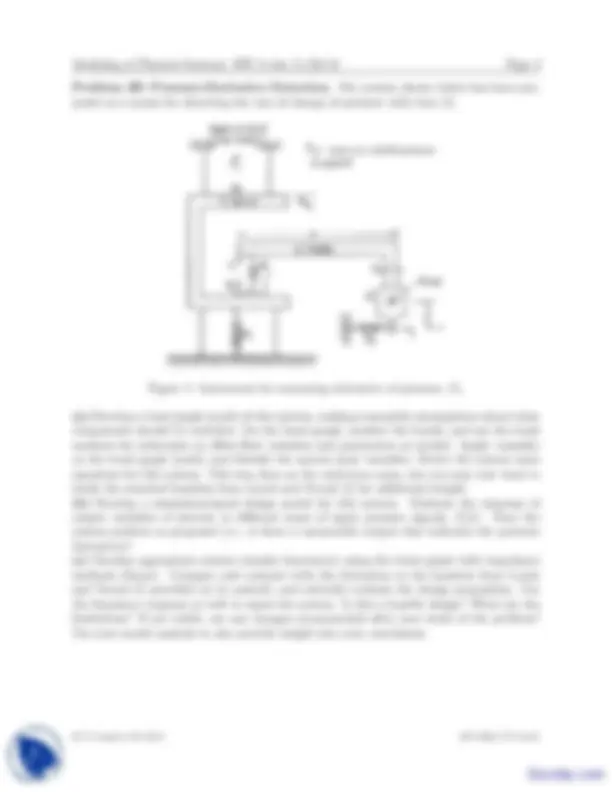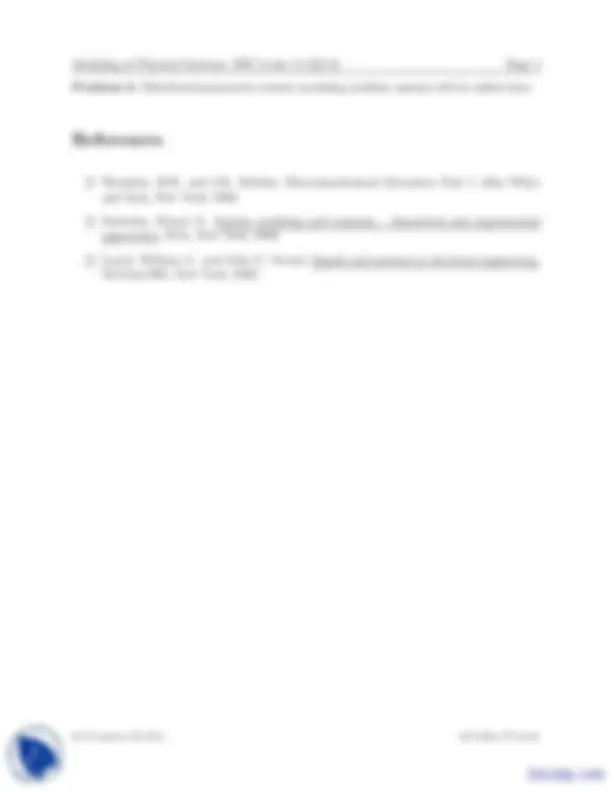




Study with the several resources on Docsity

Earn points by helping other students or get them with a premium plan


Prepare for your exams
Study with the several resources on Docsity

Earn points to download
Earn points by helping other students or get them with a premium plan
Community
Ask the community for help and clear up your study doubts
Discover the best universities in your country according to Docsity users
Free resources
Download our free guides on studying techniques, anxiety management strategies, and thesis advice from Docsity tutors
The homework assignment for modeling of physical systems course (me 383q) at ut-austin, due on 11/29/12. It includes two problems, one on deriving reluctance parameters, magneto-mechanical potential energy function, em torque, bond graph, and state equations for a device with a magnetic circuit, and another on developing a bond graph model, transfer function, time-domain simulation, and system transfer function(s) for an electromechanical shaker or a pressure-derivative detection system. References to woodson and melcher, doebelin, and lynch and truxal are provided.
Typology: Exercises
1 / 4

This page cannot be seen from the preview
Don't miss anything!



Problem 1: Work this problem from Woodson and Melcher [1]:
Refer to the following as you work through steps a to e: (a) Sketch an equivalent magnetic circuit for this device/system using magnetic variables (do not use IC multiport). Explain the significance of using infinitely permeable materials in deriving reluctance parameters as needed. Find the magnetomotive force, M = M (ϕ, θ), where ϕ is magnetic flux, rather than the flux linkage, λ(i, θ). (b) Derive the magneto-mechanical potential energy function, E(ϕ, θ), rather than the ‘mag- netic coenergy’, W ′ m(i, θ). (c) Derive the EM torque, T e(ϕ, θ). (d) Develop a complete bond graph for this system, apply causality, and derive state equa- tions. Do not use current as an input, but instead use a voltage. Also, include some electrical resistance in the coil, linear damping in the rotational pivot, and sliding friction at the wedge/yoke interface. (e) What happens to your system if you change to a current input as specified here. Solve this problem for that case.
R.G. Longoria, Fall 2012 ME 383Q, UT-Austin
Problem 2: Work either 2A or 2B. Problem 2A: Response of Electromechanical Shaker. The electromechanical shaker shown below has theoretical (right top) and measured frequency response results (bottom) as provided by Doebelin [2].
(a) Develop a bond graph model of this system, having input voltage ei(t). (b) Use impedance methods to derive a transfer function between the velocity of the table (Mt) and the input voltage. (c) Use the parameter values given be- low to determine the frequency response of table acceleration for voltage input. Compare with the results provided. Plot the magnitude and phase functions (e.g., using the bode() function in Matlab). (d) Use a time-domain simulation of the shaker to determine the pulse response results. You will need to shape the input voltage waveform, ei(t), as Doebelin has done (see below - plot same values).
Parameters: L=0.0012 H, R=3.0 Ω, Ktc = 8. 16 × 108 N/m, Kf /i=190 N/amp, Ke/v= V/(m/s), Btc=3850 N/(m/s), Mc=1.815 kg, Mt=6.12 kg, Kf = 6. 3 × 105 N/m, Bf = N/(m/s)
R.G. Longoria, Fall 2012 ME 383Q, UT-Austin
Problem 3: Distributed-parameter system modeling problem options will be added here.
[1] Woodson, H.H., and J.R. Melcher, Electromechanical Dynamics, Part I, John Wiley and Sons, New York, 1968.
[2] Doebelin, Ernest O., System modeling and response : theoretical and experimental approaches, Wile, New York, 1980.
[3] Lynch, William A., and John G. Truxal, Signals and systems in electrical engineering, McGraw-Hill, New York, 1962.
R.G. Longoria, Fall 2012 ME 383Q, UT-Austin